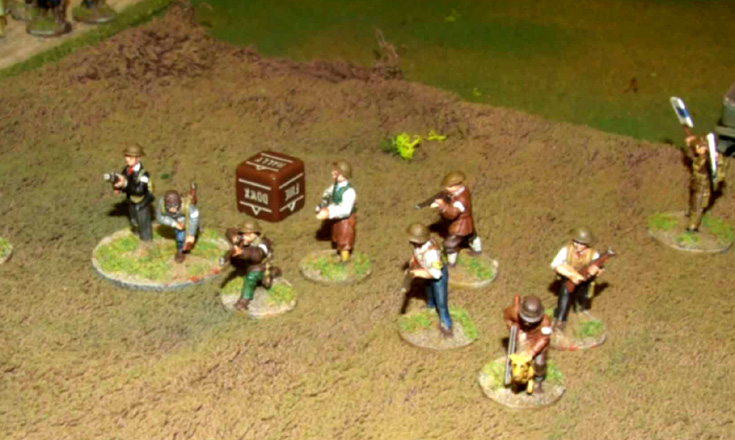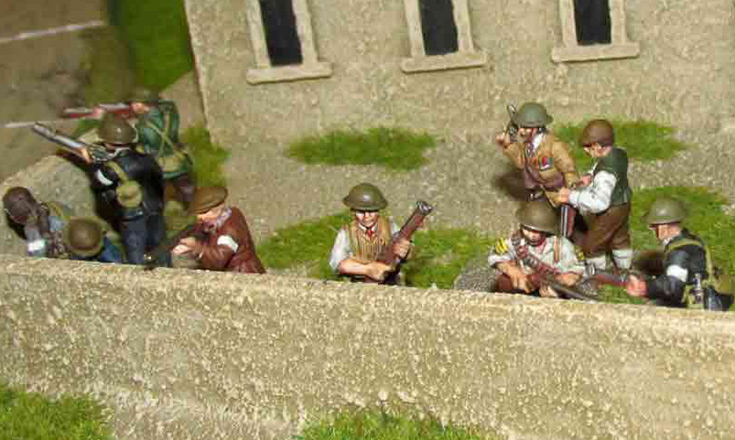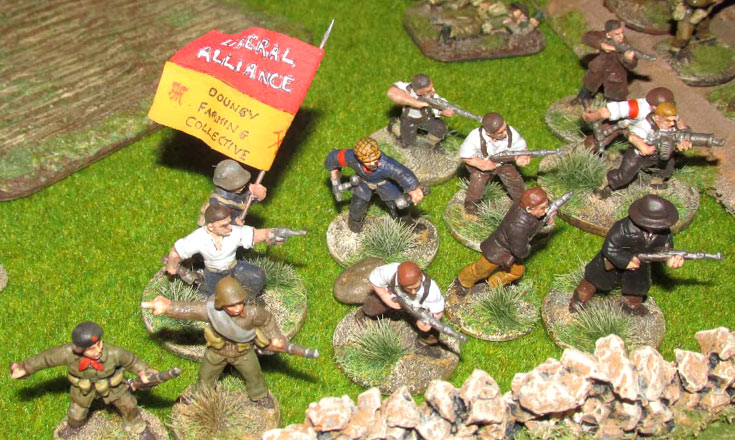
Gaitnip, Orkney, 1938
18th May 2013, 0 Comments
A Very British Civil War, Bolt Action, 28mm
I was going to play a Second World War skirmish game this week, but Warlord didn’t deliver my Stug in time. North Star and Warlord are next door to each other in Nottingham, but one delivers in two days, the other takes over twelve days and still counting. So, with no Stug, I decided to run a Very British Civil War skirmish instead. The idea was to use the same rules -Bolt Action – a set we haven’t used for the VBCW before. The Orkney back story can be found in the link at the bottom, but in this game the Royal Navy – who have declared for Prince Albert – have established an outpost at the village of Holm, on Orkney’s East Mainland. Six miles to the north is Kirkwall, the main town in Orkney, which is held by troops loyal to King Edward. Having just acquired an antiquated armoured car the Orkney Territorial Army (TA) launched a reconnaissance in force down the Holm road. Three miles outside Kirkwall they encountered a powerful Albertine blocking force. The Edwardian loyalists had three squads of TA at their disposal, plus two squads of police and police auxiliaries (“Black & Tans”), and a squad of the right wing County Militia. They were supported by a brace of TA Vickers machine guns, and “Earl Sigurd”, the TA’s newly-acquired 20 year old Rolls Royce armoured car. Facing them were two squads of sailors, two of Royal Marines, and one of Liberal Alliance militia. The marines were the only properly trained soldiers in the skirmish, and had a range of support weapons – a Boys AT rifle, a 3-inch mortar and a Vickers MMG. They also had a FOO, with a radio link to a destroyer anchored off Holm. It would come in very handy during the coming battle. Chris Werb commanded the Albertines, while I took charge of the Edwardians. We fought on a little 6×4 foot table.
The Edwardian loyalists had three squads of TA at their disposal, plus two squads of police and police auxiliaries (“Black & Tans”), and a squad of the right wing County Militia. They were supported by a brace of TA Vickers machine guns, and “Earl Sigurd”, the TA’s newly-acquired 20 year old Rolls Royce armoured car. Facing them were two squads of sailors, two of Royal Marines, and one of Liberal Alliance militia. The marines were the only properly trained soldiers in the skirmish, and had a range of support weapons – a Boys AT rifle, a 3-inch mortar and a Vickers MMG. They also had a FOO, with a radio link to a destroyer anchored off Holm. It would come in very handy during the coming battle. Chris Werb commanded the Albertines, while I took charge of the Edwardians. We fought on a little 6×4 foot table. The game began with the TA advancing across Markstone Moss, a small heather-clad hill to the left of the road, while the police and auxiliaries advanced up the road, supported by “Earl Sigurd”. The squad of County Militia (whose tweed-clad ranks included a Golden Retriever) formed a link between the two groups. For their part the Liberal Alliance squad and a squad of sailors moved up to a stone wall between a wheat field and a small farm, while the marines and another squad of sailors held the farm, and advanced onto the Moss. The opening shot came when the Boys AT rifle fired at “Earl Sigurd” from the farmyard, and missed. The Albertines had better luck with their mortar. The TA deployed their machine guns on the far side of the cornfield, but a lucky piece of targeting by the mortar spotter put paid to one of the two Edwardian Vickers teams. The other one soon fell foul of Lewis gun fire from the sailors lining the wall.
The game began with the TA advancing across Markstone Moss, a small heather-clad hill to the left of the road, while the police and auxiliaries advanced up the road, supported by “Earl Sigurd”. The squad of County Militia (whose tweed-clad ranks included a Golden Retriever) formed a link between the two groups. For their part the Liberal Alliance squad and a squad of sailors moved up to a stone wall between a wheat field and a small farm, while the marines and another squad of sailors held the farm, and advanced onto the Moss. The opening shot came when the Boys AT rifle fired at “Earl Sigurd” from the farmyard, and missed. The Albertines had better luck with their mortar. The TA deployed their machine guns on the far side of the cornfield, but a lucky piece of targeting by the mortar spotter put paid to one of the two Edwardian Vickers teams. The other one soon fell foul of Lewis gun fire from the sailors lining the wall. On Markstone Moss the squad of sailors reached the brow of the small hill, accompanied by two Universal Carriers manned by Royal Marines. They proved a battle-winner, as the Orkney TA had nothing to match them with. All attempts at closing with them failed as the TA units had too many pin markers to move – they kept failing their activation rolls. Instead they were slowly whittled down by fire from the two carriers, and from the sailors’ Lewis gun. Eventually one of the two TA squads was wiped out, while the other was reduced to grimly holding its ground, the men pinned down in the heather.
On Markstone Moss the squad of sailors reached the brow of the small hill, accompanied by two Universal Carriers manned by Royal Marines. They proved a battle-winner, as the Orkney TA had nothing to match them with. All attempts at closing with them failed as the TA units had too many pin markers to move – they kept failing their activation rolls. Instead they were slowly whittled down by fire from the two carriers, and from the sailors’ Lewis gun. Eventually one of the two TA squads was wiped out, while the other was reduced to grimly holding its ground, the men pinned down in the heather. Over on the road things were also going badly for the Edwardians. The marine FOO called in a naval gunfire support mission, and the shells landed smack on target, causing heavy pinning but no casualties to the police, the auxiliaries and the County militia. The police were the first to recover from this setback, but the better-trained auxiliaries didn’t manage to get moving again for the rest of the game. “Earl Sigurd” was still being fired on by the AT rifle, so the armoured car rolled forward and machine gunned the wooden-walled farm outhouse where the where the AT team were hiding. Some lucky dice rolling led to the team being knocked out, which of course left the Rolls Royce armoured car ruling the roost in the centre of the table. This turn-around for the Edwardians didn’t last long. The marine garrison in the farm sortied out onto the road, and tried to close-assault the armoured car using anti-tank grenades and sticky bombs. Using its “Recce” ability the Rolls Royce backed away at high speed, and while it lived to fight another day it also revealed the precariousness of the Edwardian position.
Over on the road things were also going badly for the Edwardians. The marine FOO called in a naval gunfire support mission, and the shells landed smack on target, causing heavy pinning but no casualties to the police, the auxiliaries and the County militia. The police were the first to recover from this setback, but the better-trained auxiliaries didn’t manage to get moving again for the rest of the game. “Earl Sigurd” was still being fired on by the AT rifle, so the armoured car rolled forward and machine gunned the wooden-walled farm outhouse where the where the AT team were hiding. Some lucky dice rolling led to the team being knocked out, which of course left the Rolls Royce armoured car ruling the roost in the centre of the table. This turn-around for the Edwardians didn’t last long. The marine garrison in the farm sortied out onto the road, and tried to close-assault the armoured car using anti-tank grenades and sticky bombs. Using its “Recce” ability the Rolls Royce backed away at high speed, and while it lived to fight another day it also revealed the precariousness of the Edwardian position. It was now clear that the Edwardians weren’t going to survive much longer. What remained of the TA were on the verge of being rolled up out on the Moss, despite the arrival of their gallant commander Major Rendall, whose morale-bolstering was all that seemed to be keeping them in the fight. The police and auxiliaries were also outnumbered and outclassed, while the County Militia (that’s them down below) hadn’t actually fired a shot in anger all evening. With some reluctance I ordered a general retreat, leaving the battlefield to the Albertines. Next time we’ll try it with more troops – and choose a sector of the island where there aren’t any Royal Marines to bolster the Albertine ranks! I was quite surprised that Bolt Action worked so well for this quirky period. The game flowed fairly well, and everything more or less behaved as it should. Having so many inexperienced troops on the table represented something of a challenge for both players (only the marines, the armoured car crew and the auxiliaries were rated “regular”), but that of course is half the fun of the game. it certainly made me realise you have to rally off “pebbles” (pin markers – we use little pebbles) before they get too numerous. We’ll certainly try the rules again for this period, but in the meanwhile I’ll play my Second World War skirmish – providing Warlord finally deliver my darned Stug.
It was now clear that the Edwardians weren’t going to survive much longer. What remained of the TA were on the verge of being rolled up out on the Moss, despite the arrival of their gallant commander Major Rendall, whose morale-bolstering was all that seemed to be keeping them in the fight. The police and auxiliaries were also outnumbered and outclassed, while the County Militia (that’s them down below) hadn’t actually fired a shot in anger all evening. With some reluctance I ordered a general retreat, leaving the battlefield to the Albertines. Next time we’ll try it with more troops – and choose a sector of the island where there aren’t any Royal Marines to bolster the Albertine ranks! I was quite surprised that Bolt Action worked so well for this quirky period. The game flowed fairly well, and everything more or less behaved as it should. Having so many inexperienced troops on the table represented something of a challenge for both players (only the marines, the armoured car crew and the auxiliaries were rated “regular”), but that of course is half the fun of the game. it certainly made me realise you have to rally off “pebbles” (pin markers – we use little pebbles) before they get too numerous. We’ll certainly try the rules again for this period, but in the meanwhile I’ll play my Second World War skirmish – providing Warlord finally deliver my darned Stug.




